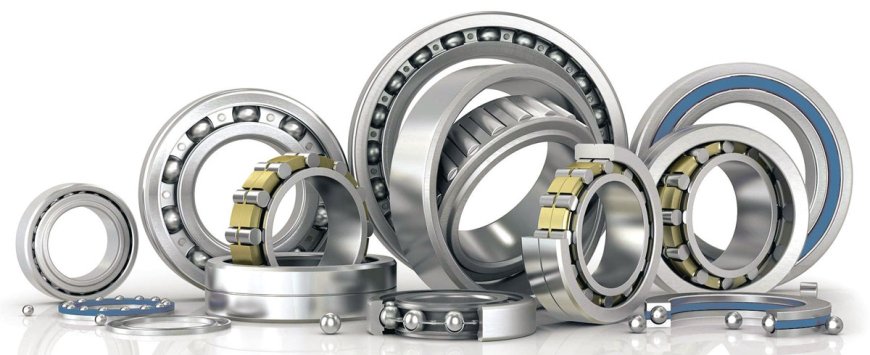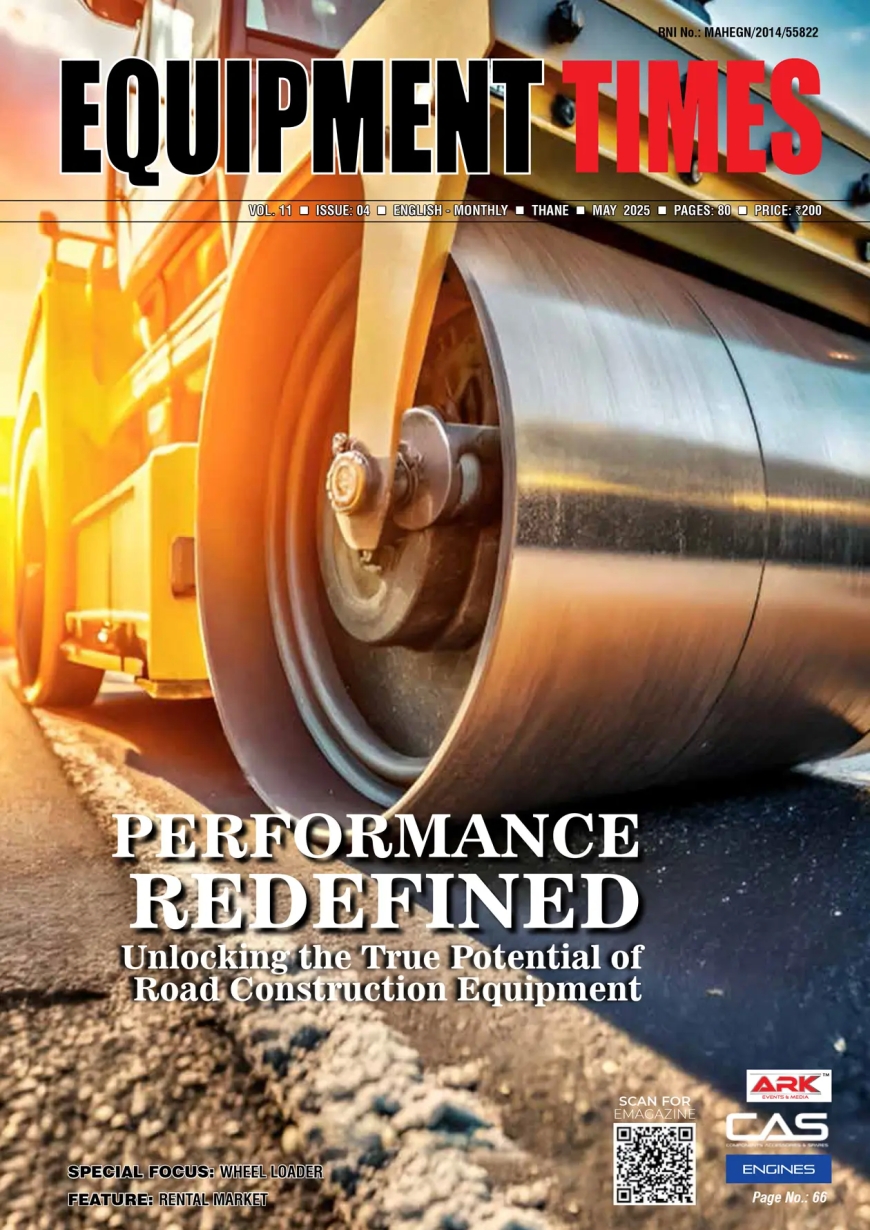REVOLUTIONIZING MOTION: BREAKTHROUGHS in the Bearing Industry

In the world of construction equipment, where robust machinery powers through the most demanding environments, one component often goes unnoticed despite being the backbone of smooth operation: bearings. These unassuming yet essential components are critical to the functionality, durability, and efficiency of construction equipment, ranging from excavators and bulldozers to cranes and loaders. Without bearings, the intricate machinery that drives the construction sector would come to a grinding halt, finds Equipment Times.
Bearings are designed to reduce friction between moving parts, support loads, and facilitate smooth rotational or linear movement. In construction equipment, they endure extreme operational conditions, including heavy loads, high speeds, intense vibrations, and exposure to dirt, water, and other contaminants. Bearings are integral to several key components of construction equipment:
Wheel Bearings: These are pivotal in ensuring the smooth movement of vehicles such as loaders and dump trucks. Wheel bearings support radial and axial loads, enhancing the mobility of heavy equipment.
Slewing Bearings: Found in cranes and excavators, slewing bearings allow for the rotation of heavy loads, ensuring precise movements and stability.
Roller Bearings: Widely used in gearboxes, engines, and transmissions, roller bearings provide reliability and high performance under heavy-duty conditions.
Pivot Bearings: Used in articulated machinery, pivot bearings enhance flexibility and enable seamless movement in tight spaces.
Technological Innovations in Bearings
Advancements in bearing technology are addressing the growing demands of the construction industry for enhanced performance, longevity, and efficiency. Key innovations include:
Sealed Bearings: Designed to prevent contamination and extend service life, sealed bearings are gaining popularity in construction equipment, particularly in dusty and wet environments.
Advanced Materials: Bearings made from high-grade steels and ceramic materials offer superior resistance to wear, corrosion, and high temperatures, making them ideal for heavy-duty applications.
Self-Lubricating Bearings: These bearings reduce the need for frequent maintenance by incorporating solid lubricants, ensuring continuous operation in remote or hard-to-reach areas.
Condition Monitoring Systems: With the advent of Industry 4.0, smart bearings equipped with sensors can monitor vibration, temperature, and load in real time. These systems provide predictive maintenance insights, minimizing downtime and maximizing equipment uptime.
The bearing industry has witnessed significant technological advancements, driving enhanced performance, durability, and efficiency in machinery across various sectors such as construction, mining, automotive, and aerospace. One of the most notable developments is the integration of smart bearings with IoT technology. These bearings are embedded with sensors that monitor real-time parameters like temperature, vibration, and load, enabling predictive maintenance and minimizing downtime. This innovation is particularly beneficial in applications such as wind turbines and heavy machinery, where operational efficiency is critical.
Advanced materials have also revolutionized the industry, with ceramic and hybrid materials offering superior strength, thermal resistance, and reduced wear. Special coatings, such as Diamond-Like Carbon (DLC) and PTFE, enhance performance under extreme conditions, while high-performance polymers and composite materials are being used for lightweight and corrosion-resistant applications. In parallel, energy-efficient bearings have been developed, featuring low-friction designs that reduce energy consumption and advanced lubrication systems utilizing nano-lubricants for extended service life and minimal environmental impact.
Another key trend is the miniaturization and customization of bearings to suit compact machinery and specific applications, such as robotics and electronics, ensuring optimal performance. Additive manufacturing, or 3D printing, is enabling rapid prototyping and the creation of complex geometries, reducing lead times and material waste. Enhanced sealing technologies, such as non-contact and labyrinth seals, are improving bearing performance by preventing contamination and maintaining reliability in harsh environments.
Sustainability has become a major focus, with manufacturers adopting eco-friendly production processes, recyclable materials, and biodegradable lubricants to minimize the environmental impact. High-speed bearings, designed for applications in electric vehicles, aerospace, and high-performance machinery, are also gaining traction due to their precision and stability.
The integration of artificial intelligence (AI) and machine learning is further transforming the industry. AI-powered systems analyze performance data, monitor conditions, and predict failures, optimizing machinery operations. Moreover, bearings are being designed for extreme applications, such as those involving high temperatures, heavy loads, and corrosive environments, to meet the rigorous demands of industries like oil and gas, mining, and deep-sea exploration.
These advancements collectively position the bearing industry at the forefront of innovation, addressing the evolving needs of modern machinery while emphasizing efficiency, reliability, and sustainability.
Challenges and Solutions
The construction sector faces several challenges in the use of bearings, including:
High Operational Stress: Bearings in construction equipment are subjected to immense stress and load. Manufacturers are addressing this by developing bearings with enhanced load-carrying capacities and superior fatigue resistance.
Contamination: Dust, debris, and water infiltration can significantly reduce bearing life. Advanced sealing technologies and proper maintenance practices are critical to mitigating these issues.
Heat and Friction: Bearings operating under extreme conditions often experience heat buildup. Innovative cooling mechanisms and high-temperature lubricants are being developed to counteract this.
Maintenance Costs: Regular maintenance is vital but can be time-consuming and expensive. The rise of self-lubricating and smart bearings is reducing the frequency and cost of maintenance.
Market Trends and Growth Drivers
The demand for bearings in the construction industry is driven by the following factors:
Infrastructure Development: Global investments in infrastructure projects are fueling the demand for advanced construction equipment and, consequently, high-performance bearings.
Focus on Efficiency: As construction companies prioritize operational efficiency and sustainability, there is a growing demand for innovative bearing solutions that enhance equipment performance and reduce energy consumption.
Rising Automation: The integration of automated and semi-automated machinery is increasing the need for precision-engineered bearings capable of supporting complex movements.
India Market for Bearings Used in Construction Equipment
Bearings play a crucial role in the smooth functioning of construction equipment, ensuring efficiency, durability, and reliability. With India’s growing infrastructure and construction activities, the demand for high-performance bearings has surged significantly. The Indian market for construction equipment bearings is evolving, driven by factors like rapid urbanization, government infrastructure projects, and advancements in bearing technology. India is witnessing robust growth in the construction equipment sector, leading to an increasing demand for specialized bearings. Bearings are used in various types of construction machinery, including excavators, bulldozers, wheel loaders, and cranes. The market is highly competitive, with both domestic and international players offering a range of solutions catering to diverse applications. According to industry reports, India’s bearing market in the construction sector is projected to grow steadily, with an increasing focus on high-load capacity and low-maintenance bearings. Leading global manufacturers and Indian companies are investing in R&D to develop bearings that can withstand harsh operating conditions, ensuring enhanced equipment life cycles.
Key market drivers include the infrastructure boom, where government initiatives such as the National Infrastructure Pipeline (NIP) and Smart Cities Mission are fueling the demand for construction equipment. Technological advancements, including innovations in bearing materials such as ceramic and hybrid bearings, enhance durability and performance under extreme conditions. Rising equipment sales and the growing adoption of advanced construction machinery necessitate the use of precision-engineered bearings. The ‘Make in India’ initiative has encouraged domestic production of bearings, reducing dependency on imports, while the push towards energy-efficient machinery has led to the demand for low-friction and longer-lasting bearings.
Despite the positive growth outlook, the Indian bearing industry faces several challenges, including counterfeit products that affect equipment performance and safety. High initial costs of advanced bearings with higher durability and performance capabilities can be a deterrent for cost-conscious buyers. Additionally, supply chain disruptions due to dependence on global supply chains for raw materials can lead to fluctuations in prices and availability.
Emerging trends and innovations in the market include smart bearings, which integrate sensors for real-time monitoring of wear and tear. Self-lubricating bearings are being adopted in heavy-duty construction equipment to reduce maintenance costs and enhance longevity. Expansion of local manufacturing by major global and domestic manufacturers is further driving market growth. Key players in the Indian market for construction equipment bearings include SKF India, Schaeffler India, Timken India, NRB Bearings, NSK India, Tata Bearings, and NTN Corporation.
The future of the Indian bearings market for construction equipment looks promising, with increasing investments in infrastructure and technological advancements driving demand. As manufacturers continue to innovate and address challenges like counterfeit products and supply chain issues, the sector is expected to witness steady growth. The trend towards sustainable and smart bearings will further shape the industry’s trajectory in the coming years. Bearings are a vital component in construction equipment, ensuring optimal performance and longevity. With India’s ongoing infrastructure development, the demand for high-quality bearings is set to rise. By adopting advanced technologies and localizing production, the industry can overcome challenges and capitalize on the growing opportunities in the Indian construction market.
While bearings may not steal the spotlight in the world of construction equipment, their importance cannot be overstated. They are the silent enablers that ensure the reliability, efficiency, and longevity of heavy machinery. As technology continues to evolve, the bearing industry is poised to deliver even more innovative solutions that meet the challenges of modern construction. By prioritizing the quality and maintenance of bearings, construction companies can achieve significant gains in productivity, cost savings, and sustainability. Indeed, in the ever-evolving landscape of construction, bearings remain the unsung heroes that keep the wheels of progress turning.








